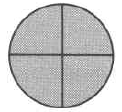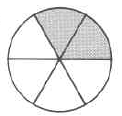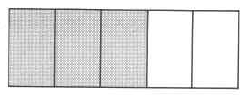4.1: Factions of Whole Numbers
- Page ID
- 48850
\( \newcommand{\vecs}[1]{\overset { \scriptstyle \rightharpoonup} {\mathbf{#1}} } \)
\( \newcommand{\vecd}[1]{\overset{-\!-\!\rightharpoonup}{\vphantom{a}\smash {#1}}} \)
\( \newcommand{\id}{\mathrm{id}}\) \( \newcommand{\Span}{\mathrm{span}}\)
( \newcommand{\kernel}{\mathrm{null}\,}\) \( \newcommand{\range}{\mathrm{range}\,}\)
\( \newcommand{\RealPart}{\mathrm{Re}}\) \( \newcommand{\ImaginaryPart}{\mathrm{Im}}\)
\( \newcommand{\Argument}{\mathrm{Arg}}\) \( \newcommand{\norm}[1]{\| #1 \|}\)
\( \newcommand{\inner}[2]{\langle #1, #2 \rangle}\)
\( \newcommand{\Span}{\mathrm{span}}\)
\( \newcommand{\id}{\mathrm{id}}\)
\( \newcommand{\Span}{\mathrm{span}}\)
\( \newcommand{\kernel}{\mathrm{null}\,}\)
\( \newcommand{\range}{\mathrm{range}\,}\)
\( \newcommand{\RealPart}{\mathrm{Re}}\)
\( \newcommand{\ImaginaryPart}{\mathrm{Im}}\)
\( \newcommand{\Argument}{\mathrm{Arg}}\)
\( \newcommand{\norm}[1]{\| #1 \|}\)
\( \newcommand{\inner}[2]{\langle #1, #2 \rangle}\)
\( \newcommand{\Span}{\mathrm{span}}\) \( \newcommand{\AA}{\unicode[.8,0]{x212B}}\)
\( \newcommand{\vectorA}[1]{\vec{#1}} % arrow\)
\( \newcommand{\vectorAt}[1]{\vec{\text{#1}}} % arrow\)
\( \newcommand{\vectorB}[1]{\overset { \scriptstyle \rightharpoonup} {\mathbf{#1}} } \)
\( \newcommand{\vectorC}[1]{\textbf{#1}} \)
\( \newcommand{\vectorD}[1]{\overrightarrow{#1}} \)
\( \newcommand{\vectorDt}[1]{\overrightarrow{\text{#1}}} \)
\( \newcommand{\vectE}[1]{\overset{-\!-\!\rightharpoonup}{\vphantom{a}\smash{\mathbf {#1}}}} \)
\( \newcommand{\vecs}[1]{\overset { \scriptstyle \rightharpoonup} {\mathbf{#1}} } \)
\( \newcommand{\vecd}[1]{\overset{-\!-\!\rightharpoonup}{\vphantom{a}\smash {#1}}} \)
\(\newcommand{\avec}{\mathbf a}\) \(\newcommand{\bvec}{\mathbf b}\) \(\newcommand{\cvec}{\mathbf c}\) \(\newcommand{\dvec}{\mathbf d}\) \(\newcommand{\dtil}{\widetilde{\mathbf d}}\) \(\newcommand{\evec}{\mathbf e}\) \(\newcommand{\fvec}{\mathbf f}\) \(\newcommand{\nvec}{\mathbf n}\) \(\newcommand{\pvec}{\mathbf p}\) \(\newcommand{\qvec}{\mathbf q}\) \(\newcommand{\svec}{\mathbf s}\) \(\newcommand{\tvec}{\mathbf t}\) \(\newcommand{\uvec}{\mathbf u}\) \(\newcommand{\vvec}{\mathbf v}\) \(\newcommand{\wvec}{\mathbf w}\) \(\newcommand{\xvec}{\mathbf x}\) \(\newcommand{\yvec}{\mathbf y}\) \(\newcommand{\zvec}{\mathbf z}\) \(\newcommand{\rvec}{\mathbf r}\) \(\newcommand{\mvec}{\mathbf m}\) \(\newcommand{\zerovec}{\mathbf 0}\) \(\newcommand{\onevec}{\mathbf 1}\) \(\newcommand{\real}{\mathbb R}\) \(\newcommand{\twovec}[2]{\left[\begin{array}{r}#1 \\ #2 \end{array}\right]}\) \(\newcommand{\ctwovec}[2]{\left[\begin{array}{c}#1 \\ #2 \end{array}\right]}\) \(\newcommand{\threevec}[3]{\left[\begin{array}{r}#1 \\ #2 \\ #3 \end{array}\right]}\) \(\newcommand{\cthreevec}[3]{\left[\begin{array}{c}#1 \\ #2 \\ #3 \end{array}\right]}\) \(\newcommand{\fourvec}[4]{\left[\begin{array}{r}#1 \\ #2 \\ #3 \\ #4 \end{array}\right]}\) \(\newcommand{\cfourvec}[4]{\left[\begin{array}{c}#1 \\ #2 \\ #3 \\ #4 \end{array}\right]}\) \(\newcommand{\fivevec}[5]{\left[\begin{array}{r}#1 \\ #2 \\ #3 \\ #4 \\ #5 \\ \end{array}\right]}\) \(\newcommand{\cfivevec}[5]{\left[\begin{array}{c}#1 \\ #2 \\ #3 \\ #4 \\ #5 \\ \end{array}\right]}\) \(\newcommand{\mattwo}[4]{\left[\begin{array}{rr}#1 \amp #2 \\ #3 \amp #4 \\ \end{array}\right]}\) \(\newcommand{\laspan}[1]{\text{Span}\{#1\}}\) \(\newcommand{\bcal}{\cal B}\) \(\newcommand{\ccal}{\cal C}\) \(\newcommand{\scal}{\cal S}\) \(\newcommand{\wcal}{\cal W}\) \(\newcommand{\ecal}{\cal E}\) \(\newcommand{\coords}[2]{\left\{#1\right\}_{#2}}\) \(\newcommand{\gray}[1]{\color{gray}{#1}}\) \(\newcommand{\lgray}[1]{\color{lightgray}{#1}}\) \(\newcommand{\rank}{\operatorname{rank}}\) \(\newcommand{\row}{\text{Row}}\) \(\newcommand{\col}{\text{Col}}\) \(\renewcommand{\row}{\text{Row}}\) \(\newcommand{\nul}{\text{Nul}}\) \(\newcommand{\var}{\text{Var}}\) \(\newcommand{\corr}{\text{corr}}\) \(\newcommand{\len}[1]{\left|#1\right|}\) \(\newcommand{\bbar}{\overline{\bvec}}\) \(\newcommand{\bhat}{\widehat{\bvec}}\) \(\newcommand{\bperp}{\bvec^\perp}\) \(\newcommand{\xhat}{\widehat{\xvec}}\) \(\newcommand{\vhat}{\widehat{\vvec}}\) \(\newcommand{\uhat}{\widehat{\uvec}}\) \(\newcommand{\what}{\widehat{\wvec}}\) \(\newcommand{\Sighat}{\widehat{\Sigma}}\) \(\newcommand{\lt}{<}\) \(\newcommand{\gt}{>}\) \(\newcommand{\amp}{&}\) \(\definecolor{fillinmathshade}{gray}{0.9}\)- understand the concept of fractions of whole numbers
- be able to recognize the parts of a fraction
More Numbers on the Number Line
In Chapters [link], [link], and [link], we studied the whole numbers and methods of combining them. We noted that we could visually display the whole numbers by drawing a number line and placing closed circles at whole number locations.

By observing this number line, we can see that the whole numbers do not account for every point on the line. What numbers, if any, can be associated with these points? In this section we will see that many of the points on the number line, including the points already associated with whole numbers, can be associated with numbers called fractions.
Fractions of Whole Numbers
The Nature of the Positive Fractions
We can extend our collection of numbers, which now contains only the whole numbers, by including fractions of whole numbers. We can determine the nature of these fractions using the number line.
If we place a pencil at some whole number and proceed to travel to the right to the next whole number, we see that our journey can be broken into different types of equal parts as shown in the following examples.
1 part.

2 equal parts.

3 equal parts.

4 equal parts.

The Latin Word Fractio
Notice that the number of parts, 2, 3, and 4, that we are breaking the original quantity into is always a nonzero whole number. The idea of breaking up a whole quantity gives us the word fraction. The word fraction comes from the Latin word "fractio" which means a breaking, or fracture.
Suppose we break up the interval from some whole number to the next whole number into five equal parts.

After starting to move from one whole number to the next, we decide to stop after covering only two parts. We have covered 2 parts of 5 equal parts. This situation is described by writing \(\dfrac{2}{5}\).

A number such as \(\dfrac{2}{5}\) is called a positive fraction, or more simply, a fraction.
The Parts of a Fraction
A fraction has three parts.
The fraction bar -.
Fraction Bar
The fraction bar serves as a grouping symbol. It separates a quantity into individual groups. These groups have names, as noted in 2 and 3 below.
The nonzero number below the fraction bar.
Denominator
This number is called the denominator of the fraction, and it indicates the number of parts the whole quantity has been divided into. Notice that the denominator must be a nonzero whole number since the least number of parts any quantity can have is one.
The number above the fraction bar.
Numerator
This number is called the numerator of the fraction, and it indicates how many of the specified parts are being considered. Notice that the numerator can be any whole number (including zero) since any number of the specified parts can be considered.
\(\dfrac{\text{whole number}}{\text{nonzero whole number}} \leftrightarrow \dfrac{\text{numerator}}{\text{denominator}}\)
The diagrams in the following problems are illustrations of fractions.
Diagrams: 


1a: A whole circle 1b: The whole circle divided into 3 equal parts 1c: 1 of the 3 equal parts
Figure 1.

The fraction \(\dfrac{1}{3}\) is read as "one third".
Diagrams: 


2a: A whole rectangle 2b: The whole rectangle divided into 5 equal parts 2c: 3 of the 5 equal parts
Figure 2.

The fraction \(\dfrac{3}{5}\) "is read as "three fifths."

3a: The number line between 0 and 1

3b: The number line between 0 and 1 divided into 7 equal parts

3c: 6 of the 7 equal parts
Figure 3.

The fraction \(\dfrac{6}{7}\) is read as "six sevenths."



4a: A whole circle 4b: The whole circle divided into 4 equal parts 4c: 4 of the 4 equal parts
Figure 4.

When the numerator and denominator are equal, the fraction represents the entire quantity, and its value is 1.
\(\dfrac{\text{nonzero whole number}}{\text{same nonzero whole number}} = 1\)
Practice Set A
Specify the numerator and denominator of the following fractions.
\(\dfrac{4}{7}\)
- Answer
-
4, 7
Practice Set A
\(\dfrac{5}{8}\)
- Answer
-
5, 8
Practice Set A
\(\dfrac{10}{15}\)
- Answer
-
10, 15
Practice Set A
\(\dfrac{1}{9}\)
- Answer
-
1, 9
Practice Set A
\(\dfrac{0}{2}\)
- Answer
-
0, 2
Reading and Writing Fractions
In order to properly translate fractions from word form to number form, or from number form to word form, it is necessary to understand the use of the hyphen.
Use of the Hyphen
One of the main uses of the hyphen is to tell the reader that two words not ordinarily joined are to be taken in combination as a unit. Hyphens are always used for numbers between and including 21 and 99 (except those ending in zero).
Write each fraction using whole numbers.
Fifty three-hundredths. The hyphen joins the words three and hundredths and tells us to consider them as a single unit. Therefore, fifty three-hundredths translates as \(\dfrac{50}{300}\)
Fifty-three hundredths. The hyphen joins the numbers fifty and three and tells us to consider them as a single unit. Therefore, fifty-three hundredths translates as \(\dfrac{53}{100}\)
Four hundred seven-thousandths. The hyphen joins the words seven and thousandths and tells us to consider them as a single unit. Therefore, four hundred seven-thousandths translates as \(\dfrac{400}{7,000}\)
Four hundred seven thousandths. The absence of hyphens indicates that the words seven and thousandths are to be considered individually. four hundred seven thousandths translates as \(\dfrac{407}{1000}\)
Write each fraction using words.
\(\dfrac{21}{85}\) translates as twenty-one eighty-fifths.
\(\dfrac{200}{3,000}\) translates as two hundred three-thousandths. A hyphen is needed between the words three and thousandths to tell the reader that these words are to be considered as a single unit.
\(\dfrac{203}{1,000}\) translates as two hundred three thousandths.
Practice Set B
Write the following fractions using whole numbers.
one tenth
- Answer
-
\(\dfrac{1}{10}\)
Practice Set B
eleven fourteenths
- Answer
-
\(\dfrac{11}{14}\)
Practice Set B
sixteen thirty-fifths
- Answer
-
\(\dfrac{16}{35}\)
Practice Set B
eight hundred seven-thousandths
- Answer
-
\(\dfrac{800}{7,000}\)
Write the following using words.
Practice Set B
\(\dfrac{3}{8}\)
- Answer
-
three eighths
Practice Set B
\(\dfrac{1}{10}\)
- Answer
-
one tenth
Practice Set B
\(\dfrac{3}{250}\)
- Answer
-
three two hundred fiftieths
Practice Set B
\(\dfrac{114}{3,190}\)
- Answer
-
one hundred fourteen three thousand one hundred ninetieths
Name the fraction that describes each shaded portion.
Practice Set B

- Answer
-
\(\dfrac{3}{8}\)
Practice Set B

- Answer
-
\(\dfrac{1}{16}\)
Practice Set B
The number \(\dfrac{5}{9}\) is used in converting from Fahrenheit to Celsius.
- Answer
-
5, 9, five ninths
Practice Set B
A dime is \(\dfrac{1}{10}\) of a dollar.
- Answer
-
1, 10, one tenth
Exercises
For the following 10 problems, specify the numerator and denominator in each fraction.
Exercise \(\PageIndex{1}\)
\(\dfrac{3}{4}\)
- Answer
-
numerator, 3; denominator, 4
Exercise \(\PageIndex{2}\)
\(\dfrac{9}{10}\)
Exercise \(\PageIndex{3}\)
\(\dfrac{1}{5}\)
- Answer
-
numerator, 1; denominator, 5
Exercise \(\PageIndex{4}\)
\(\dfrac{5}{6}\)
Exercise \(\PageIndex{5}\)
\(\dfrac{7}{7}\)
- Answer
-
numerator, 7; denominator, 7
Exercise \(\PageIndex{6}\)
\(\dfrac{4}{6}\)
Exercise \(\PageIndex{7}\)
\(\dfrac{0}{12}\)
- Answer
-
numerator, 0; denominator, 12
Exercise \(\PageIndex{8}\)
\(\dfrac{25}{25}\)
Exercise \(\PageIndex{9}\)
\(\dfrac{18}{1}\)
- Answer
-
numerator, 18; denominator, 1
Exercise \(\PageIndex{10}\)
\(\dfrac{0}{16}\)
For the following 10 problems, write the fractions using whole numbers.
Exercise \(\PageIndex{11}\)
four fifths
- Answer
-
\(\dfrac{4}{5}\)
Exercise \(\PageIndex{12}\)
two ninths
Exercise \(\PageIndex{13}\)
fifteen twentieths
- Answer
-
\(\dfrac{15}{20}\)
Exercise \(\PageIndex{14}\)
forty-seven eighty-thirds
Exercise \(\PageIndex{15}\)
ninety-one one hundred sevenths
- Answer
-
\(\dfrac{91}{107}\)
Exercise \(\PageIndex{16}\)
twenty-two four hundred elevenths
Exercise \(\PageIndex{17}\)
six hundred five eight hundred thirty-fourths
- Answer
-
\(\dfrac{605}{834}\)
Exercise \(\PageIndex{18}\)
three thousand three forty-four ten-thousandths
Exercise \(\PageIndex{19}\)
ninety-two one-millionths
- Answer
-
\(\dfrac{92}{1,000,000}\)
Exercise \(\PageIndex{20}\)
one three-billionths
For the following 10 problems, write the fractions using words.
Exercise \(\PageIndex{21}\)
\(\dfrac{5}{9}\)
- Answer
-
five ninths
Exercise \(\PageIndex{22}\)
\(\dfrac{6}{10}\)
Exercise \(\PageIndex{23}\)
\(\dfrac{8}{15}\)
- Answer
-
eight fifteenths
Exercise \(\PageIndex{24}\)
\(\dfrac{10}{13}\)
Exercise \(\PageIndex{25}\)
\(\dfrac{75}{100}\)
- Answer
-
seventy-five one hundredths
Exercise \(\PageIndex{26}\)
\(\dfrac{86}{135}\)
Exercise \(\PageIndex{27}\)
\(\dfrac{916}{1,014}\)
- Answer
-
nine hundred sixteen one thousand fourteenths
Exercise \(\PageIndex{28}\)
\(\dfrac{501}{10,001}\)
Exercise \(\PageIndex{29}\)
\(\dfrac{18}{31,608}\)
- Answer
-
eighteen thirty-one thousand six hundred eighths
Exercise \(\PageIndex{30}\)
\(\dfrac{1}{500,000}\)
For the following 4 problems, name the fraction corresponding to the shaded portion.
Exercise \(\PageIndex{31}\)

- Answer
-
\(\dfrac{1}{2}\)
Exercise \(\PageIndex{32}\)

Exercise \(\PageIndex{33}\)

- Answer
-
\(\dfrac{4}{7}\)
Exercise \(\PageIndex{34}\)

For the following 4 problems, shade the portion corresponding to the given fraction on the given figure.
Exercise \(\PageIndex{35}\)
\(\dfrac{3}{5}\)

- Answer
-

Exercise \(\PageIndex{36}\)
\(\dfrac{1}{8}\)

Exercise \(\PageIndex{37}\)
\(\dfrac{6}{6}\)

- Answer
-

Exercise \(\PageIndex{38}\)
\(\dfrac{0}{3}\)

State the numerator and denominator and write in words each of the fractions appearing in the statements for the following 10 problems.
Exercise \(\PageIndex{39}\)
A contractor is selling houses on \(\dfrac{1}{4}\) acre lots.
- Answer
-
Numerator, 1; denominator, 4; one fourth
Exercise \(\PageIndex{40}\)
The fraction \(\dfrac{22}{7}\) is sometimes used as an approximation to the number \(\pi\). (The symbol is read “pi.")
Exercise \(\PageIndex{41}\)
The fraction \(\dfrac{4}{3}\) is used in finding the volume of a sphere.
- Answer
-
Numerator, 4; denominator, 3; four thirds
Exercise \(\PageIndex{42}\)
One inch is \(\dfrac{1}{12}\) of a foot.
Exercise \(\PageIndex{43}\)
About \(\dfrac{2}{7}\) of the students in a college statistics class received a “B” in the course.
- Answer
-
Numerator, 2; denominator, 7; two sevenths
Exercise \(\PageIndex{44}\)
The probability of randomly selecting a club when drawing one card from a standard deck of 52 cards is \(\dfrac{13}{52}\).
Exercise \(\PageIndex{45}\)
In a box that contains eight computer chips, five are known to be good and three are known to be defective. If three chips are selected at random, the probability that all three are defective is \(\dfrac{1}{56}\).
- Answer
-
Numerator, 1; denominator, 56; one fifty-sixth
Exercise \(\PageIndex{46}\)
In a room of 25 people, the probability that at least two people have the same birthdate (date and month, not year) is \(\dfrac{569}{1000}\).
Exercise \(\PageIndex{47}\)
The mean (average) of the numbers 21, 25, 43, and 36 is \(\dfrac{125}{4}\).
- Answer
-
Numerator, 125; denominator, 4; one hundred twenty-five fourths
Exercise \(\PageIndex{48}\)
If a rock falls from a height of 20 meters on Jupiter, the rock will be \(\dfrac{32}{25}\) meters high after \(\dfrac{6}{5}\) seconds.
Exercises For Review
Exercise \(\PageIndex{49}\)
Use the numbers 3 and 11 to illustrate the commutative property of addition.
- Answer
-
\(3 + 11 = 11 + 3 = 14\)
Exercise \(\PageIndex{50}\)
Find the quotient. \(676 \div 26\)
Exercise \(\PageIndex{51}\)
Write \(7 \cdot 7 \cdot 7 \cdot 7 \cdot 7\) using exponents.
- Answer
-
\(7^5\)
Exercise \(\PageIndex{52}\)
Find the value of \(\dfrac{8 \cdot (6 + 20)}{8} + \dfrac{3 \cdot (6 + 16)}{22}\).
Exercise \(\PageIndex{53}\)
Find the least common multiple of 12, 16, and 18.
- Answer
-
144


